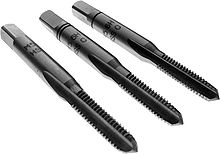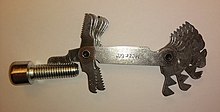Taps
A tap is a drill used to create an internal thread ( threaded hole ) in metal , plastic or other solid materials . The process is called " tapping " (also "screw drilling"). The terms nut drills and screw drills or tapping drills are also known . The name “ nut drill” refers to its use in the manufacture of screw nuts . The name "screwdriver" implies that the feed rate of the drill must correspond exactly to the thread pitch (the drill " screws " into the threaded hole).
The corresponding tool for cutting external threads (e.g. on a screw) is the die .
Usually the tap only cuts the thread. The actual hole must first be pre-drilled with an ordinary drill . According to DIN 8580, tapping belongs to the main group “ cutting ” as a machining production process . Special threads can also be produced by cold forming with a thread former . However, this is not part of the machining process, as the thread former has no cutting surfaces, but rather deforms the thread into the material.
construction
Depending on its size, a tap has two or more cutting edges . The cutting edges have teeth that each remove a chip from the material to be machined and plastically deform the material to a small extent. The teeth at the tip of the tap are flattened to different degrees (chamfer). As a result, when cutting, each tooth takes a chip of roughly the same width with it. The teeth further back serve only to guide the tap in the already cut part of the thread. At the rear end, hand taps usually have an external square (rarely also hexagon or round) with which they can be clamped in a holder, the tap wrench.
variants
Depending on the type of threaded hole and the material, a distinction is made between incision taps and tap sets. In addition, a distinction is made between manual processing and machine processing.
Tap set
A tap set usually consists of the three taps: pre-cutter , middle cutter and finishing cutter . The pre-cutter is marked with a ring on the shaft, the middle cutter with two rings. The finishing cutter does not wear a ring or (less often) three rings.
Short Machine Taps
Single-cut taps offer the advantage of saving time, as only one pass is required to produce the thread. Since a wider chip is removed than with three-part blocks and thus a greater torque is required, they are mostly used on machines.
For blind holes ( i.e. not continuous, blind holes) for right-hand threads ("normal" threads), taps with spiral grooves turned to the right are required, which convey the chip out of the hole against the cutting direction. For through-holes, taps with straight flutes, less often with left-handed spiral flutes, are used.
Hand taps are mostly made of high speed steel (HSS).
application
Determine diameter and pitch
The thread parameters must be determined before drilling . These either result from the construction drawing or have to be measured on a component. The outside diameter of the thread is measured with the caliper . The pitch is measured on an associated screw with the thread gauge . Standard threads have a pitch defined for the thread diameter. (see table below)
Drill core hole
| thread | pitch | Core hole ⌀ |
|---|---|---|
| M12 | x 1.75 | 10.2 |
| M10 | x1.5 | 8.5 |
| M8 | x1.25 | 6.8 |
| M6 | x1 | 5.0 |
| M5 | x0.8 | 4.2 |
| M4 | x0.7 | 3.3 |
| M3 | x0.5 | 2.5 |
To cut an internal thread, a core hole is first drilled, the diameter of which is approximately the pitch smaller than the nominal diameter of the thread. For example, with a standard thread M10 with a thread pitch of 1.5 mm, a blind hole with a diameter of 10 mm - 1.5 mm = 8.5 mm should be made. In order to get a better introduction into the hole when cutting and to prevent the first and last thread turn from being pushed out, a countersink is made. This corresponds to the size of the thread diameter plus 10%. With an M10 thread this is 10 mm + 1 mm, i.e. a countersink with a diameter of 11 mm.
Cutting oil
To increase the service life of the tools and for optimal surface quality , cutting oils or other cooling lubricants are used for lubrication . This reduces the friction between the chip and the cutting edges of the tap and thus also the required torque. In the case of non-industrial production, simple motor oil is also used, alcohol helps for aluminum.
threading
The cutting taps - or the three taps one after the other - are slowly turned in and out again. Cutting and additional plastic deformation of the thread flanks creates the final core hole diameter, which for M10 is 8.38 mm.
If possible, the tap should not be turned back while cutting , since frequent shearing of the chips and new cutting lead to premature blunting of the tap edges . Exception: In the case of long-chipping materials (thermoplastics, aluminum-bronze, individual types of bronze, individual types of brass, individual types of aluminum) and larger threads, the chips must be broken repeatedly. This is done by turning the tap by about 1 / 4 turn or in the turning until a slight "pops" off. At the same time, fresh lubricant reaches the cutting edges.
Cut long threads
Especially with threads that are not significantly longer than their diameter, the axis of the thread becomes very slightly inclined when cutting by hand. In contrast, usually only machine cutting helps. Alternatively, the spindle of a column or column drilling machine with a clamped tap can be rotated manually. Standardized small and medium-sized internal threads can be easily and inexpensively produced on the lathe using taps.
See also
literature
- EMUGE-FRANKEN (Ed.): Handbook of thread technology and milling technology - applications, tips, tables , 2004, 183–255, 284–296.
- Thomas Zeus: Tapping in: Uwe Heisel, Fritz Klocke, Eckart Uhlmann, Günter Spur: Handbuch Spanen. 2nd edition, Hanser, Munich 2014, pp. 1034-1040.
Web links
Individual evidence
- ↑ Heinz Tschätsch: Practice of machining technology. Process, tools, calculation. 11th edition, Springer Vieweg, Wiesbaden 2014, p. 122.


